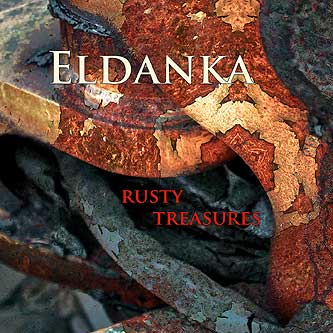 Finland
continues giving the music world great guitarists who create equally
great instrumental guitar albums. In the spirit of the 1960s and specifically,
the sounds of U.K. guitar heroes The Shadows, as well as the upbeat
West Coast instro sound of surf legends The Ventures, Rusty
Treasures is a fantastic showcase for the Finnish band Eldanka
and their talented guitarist / composer Mika Jämsä.
The liner notes say the album, released in 2018, was recorded live
in the studio in the band's native town of Toholampi Finland in 2017.
Featuring a dozen original instrumentals, the accent here is on the
superbly recorded sound, featuring excellent group interplay. Speaking
to mwe3.com about the mix of instrumental Finnish traditional music,
rock, folk, jazz and classical on Rusty Treasures, Mika explains,
"In
my music you can hear all the music styles I’ve gnawed on. I
try to do music I’d like to listen to myself. The only restriction
is that it's played with simple, traditional vintage instruments.
Instrumental music melodies must be interesting and everything has
to support that. Certainly we try to arrange pieces that are interesting
to play." A
number of players assist Mika, including his Eldanka bandmates Rasmus
Tammik (rhythm guitar), Mauri Haapamäki (bass) and
Janne Torvikoski (drums). Featuring 12 tracks clocking in at
37 minutes, Rusty Treasures is the coolest sounding album yet
by Finland’s finest instrumental rockers Eldanka. www.facebook.com
/ www.bandcamp.com
Finland
continues giving the music world great guitarists who create equally
great instrumental guitar albums. In the spirit of the 1960s and specifically,
the sounds of U.K. guitar heroes The Shadows, as well as the upbeat
West Coast instro sound of surf legends The Ventures, Rusty
Treasures is a fantastic showcase for the Finnish band Eldanka
and their talented guitarist / composer Mika Jämsä.
The liner notes say the album, released in 2018, was recorded live
in the studio in the band's native town of Toholampi Finland in 2017.
Featuring a dozen original instrumentals, the accent here is on the
superbly recorded sound, featuring excellent group interplay. Speaking
to mwe3.com about the mix of instrumental Finnish traditional music,
rock, folk, jazz and classical on Rusty Treasures, Mika explains,
"In
my music you can hear all the music styles I’ve gnawed on. I
try to do music I’d like to listen to myself. The only restriction
is that it's played with simple, traditional vintage instruments.
Instrumental music melodies must be interesting and everything has
to support that. Certainly we try to arrange pieces that are interesting
to play." A
number of players assist Mika, including his Eldanka bandmates Rasmus
Tammik (rhythm guitar), Mauri Haapamäki (bass) and
Janne Torvikoski (drums). Featuring 12 tracks clocking in at
37 minutes, Rusty Treasures is the coolest sounding album yet
by Finland’s finest instrumental rockers Eldanka. www.facebook.com
/ www.bandcamp.com
mwe3.com presents an interview with
Mika Jämsä of Eldanka
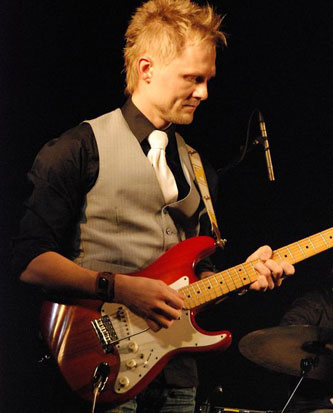 mwe3:
Can you tell the readers where you’re from originally and where
you live now and what do you like best about it? What other cities
and towns do you enjoy and what about traveling to other countries
and the US?
mwe3:
Can you tell the readers where you’re from originally and where
you live now and what do you like best about it? What other cities
and towns do you enjoy and what about traveling to other countries
and the US?
Mika Jämsä: I live in the middle part of Finland.
My hometown, Toholampi is a little village in the area where the population
is quite thin and nature-near. Instead of large crowds of people,
we have a lot of space and long distances. We have the fresh air to
breath, clean spring water to drink and silence to hear everywhere.
Summer nights are bright and winter days are cold, short and dark.
When we need to play together there’s many possibilities to find
a free place. Everything is easy-going here.
I appreciate places where people live in harmony with nature and that
have some original and historical features left. The places with a
lot of population are nice to visit but not to live. As a musician
I have to admit big cities are lively and there’s the audience.
Otherwise, I’d like to avoid tourist traps. Still this summer,
I’m going to see Rome.
So far I’ve visited only the European cities from St. Petersburg
to London but not yet in the US. A big dream is to see America and
play there for surf music lovers. Maybe I’ll take a road trip
through musical historic places like New Orleans, Memphis etc.
mwe3: When did you start playing guitar and who were and still
are some of your major guitar influences?
Mika Jämsä: I started playing on my father’s
Fender Stratocaster. He was a guitarist in a dance band and took his
smoky equipment home after weekend tours. My job was to clean the
guitar and replace the strings. The ideal sound was sparkly and clean
with long echo, while other kids listened to glam rock. My
Dad left me two Stratocasters that I’m playing now. When he was
still active in the 1980’s, he wasn’t satisfied with his
'71 original US Fender Startocaster and ordered a new body from the
local carpenter Juha Ala-Kuha. That brown sunburst guitar still didn’t
please him maybe because the neck was quite thin. He gave "Jussi"
a commission to make a whole new and totally perfect Stratocaster.
The outcome was the red sunburst copy of a '57 Stratocaster with a
maple neck and warm tone. That really is a perfect vintage style Stratocaster.
For the '71 brown Strat I ordered later from Jussi, I wanted a thicker
birdseye maple neck instead of the original thin rosewood neck and
Fender changed completely to JAK. For both guitars I fitted with the
Finnish EKT
steel guitar parts. They both have also a little extra switch to combine
the neck pickup to other combinations. That gives me an opportunity
to use extra neck-bridge and neck-middle-bridge combinations.
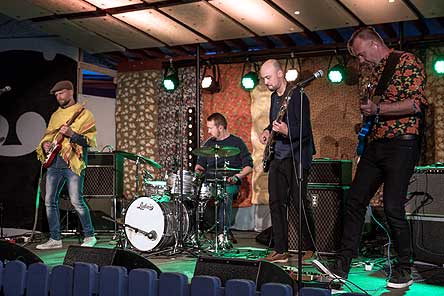 Among
the first records I found at home was a fascinating Finnish Rautalanka
collection from the 1960’s. I also listened to the Finnish band
The Mustangs, The Spotnicks and also the Shadows albums. As a youngster,
I managed to play with them, even the Shadows’ version of “Mozart
Forte”. Dire Straits early albums were also played a lot in my
home.
Among
the first records I found at home was a fascinating Finnish Rautalanka
collection from the 1960’s. I also listened to the Finnish band
The Mustangs, The Spotnicks and also the Shadows albums. As a youngster,
I managed to play with them, even the Shadows’ version of “Mozart
Forte”. Dire Straits early albums were also played a lot in my
home.
I studied classical guitar in my youth, up until I had to choose either
classical guitar professional studies or a musical education in the
university. I chose teaching and practically left the classical guitar.
I played a great amount of splendid material, especially from the
romantic period of guitar repertoire and now I’ve taken the notes
up again. Spanish and Latin American composers made the smoothest
works for classical guitar. In my youth, I spent thousands of hours
to improve classical right hand finger style technique, which doesn’t
help now with a pick at all.
mwe3:
After hearing the Rusty Treasures album by Eldanka, I feel
safe to say that the spirit of The Shadows is alive and well in Finland.
Mika Jämsä: The most awesome guitarist that blew
me away is the Finnish king of guitar, Mr. Esa Pulliainen from Topi
Sorsakoski & The Agents. He has a warm unique and a magical sound
with a minimalist expression. His band did everything with an honest
sound and a very noncommercial, trampy style. The hype against old
Vox’s in Finland comes more from him than any other 1960’s
British idols. He said that he tried to get the sound of Hank Marvin
but failed, maybe because of his extremely thick strings... a 13’
or even 14’ set.
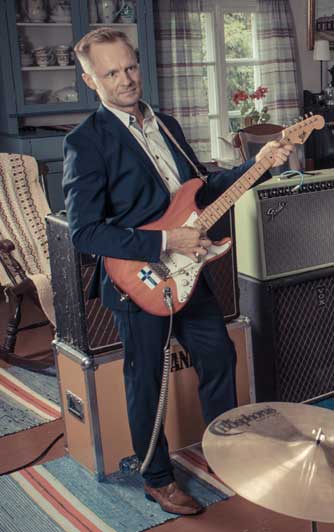 Actually
I found the surf genre later by way of Laika & the Cosmonauts.
They gave me an example to make my own shameless guitar tunes without
any restrictions, but with a great sense of humor. They also provided
me with a distinction between sparkly Fender and shabby Vox tube amplifiers...
was the British or American sound the ideal? They’re an example
of surf band with Rautalanka roots.
Actually
I found the surf genre later by way of Laika & the Cosmonauts.
They gave me an example to make my own shameless guitar tunes without
any restrictions, but with a great sense of humor. They also provided
me with a distinction between sparkly Fender and shabby Vox tube amplifiers...
was the British or American sound the ideal? They’re an example
of surf band with Rautalanka roots.
mwe3: I wanted to ask you about the name of the band. Eldanka
is an interesting band name.
Mika Jämsä: The name Eldanka? There are two little
Joldanka lakes in the Republic of Karelia, Russia, and there were
battles there between Finns and Russians during the Second World War.
Finnish soldiers wrongly read the Cyrillian spelling from the Russian
map, and the Finnish counter word of Joldanka is Eldanka. I only have
Finnish map with Finnish names. You can also search Joutanki lakes
or Eldanka lakes. When we read the original Russian name and cyrilic
letters ”wrong” we get Eldanka. Also Spanish words contain
an ”El”, and that’s another link to a surf genre. There’s
also a
wartime hit tune regarding the events in Eldanka Lake. Finnish
folk music and therefore, the Rautalanka genre have lots of influences
from Russian romantic folk melodies. (see
here
and here)
mwe3: Eldanka and other Finnish instro bands combined both
what is usually called instrumental surf-rock with the Finnish ‘Rautalanka’
sound.
Mika
Jämsä: The first influences and examples of instrumental
rock music came here in the 1960s from our neighbors Sweden and other
Nordic countries. They played international hit tunes from the UK
and USA. Also, the first way to hear foreign music was on radio. Finland
was a part of Russia during the 19th century. Many Finnish and Russian
folk songs are recorded as Finnish Rautalanka versions. In spite of
fighting against the Soviet Union there were a lot of influences and
links to our own music. Bands took wartime accordion hit waltzes in
a minor key and played it with a rapid beat or twist and also folk
songs were played. Familiar tunes were the way to make the Finnish
hit list in the early years. But the Finnish oddity and a major difference
between Swedish or American surf music is that we play almost anything
in a minor key and major keys feel nothing less than frivolous. Finnish
Rautalanka bands concentrate on playing, not smiling. But if you once
raise your feet or guitar necks simultaneously, the audience will
be enthralled. Some bands have recently found that sunglasses, supposing
they’re very hot, covers their identity when they smile.
mwe3: Can you tell non-Finns what Rautalanka is and how Finnish
traditional music, folk, jazz and classical influenced your composing?
Mika Jämsä: In my music you can hear all the music
styles I’ve gnawed on. I try to do music I’d like to listen
myself. The only restriction is that it's played by the simple traditional
vintage instruments. Instrumental music melodies must be interesting
and everything has to support that. Certainly we try to arrange pieces
that are interesting to play.
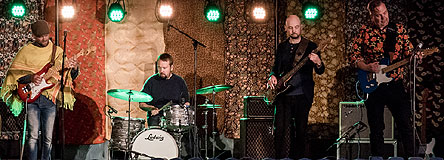 mwe3:Were
you influenced by the late great Finnish composer Pekka Pohjola who
was the greatest of the 20th century jazz-rock composers in Finland?
I was lucky enough to meet and work on several album releases by Pekka
Pohjola.
mwe3:Were
you influenced by the late great Finnish composer Pekka Pohjola who
was the greatest of the 20th century jazz-rock composers in Finland?
I was lucky enough to meet and work on several album releases by Pekka
Pohjola.
Mika Jämsä: Pekka Pohjola uses themes from Finnish
nature and fauna so the music is progressive rock or jazz with Finnish
elements. While Sibelius was the first Finnish composer making identifiably,
unique Finnish music, Pekka did the same in jazz-rock genre. Are we
executing that with our genre? Well, maybe we at least try. Our second
album compared to the first one has more elements from folk music.
But while Pekka operated more in the genre of jazz, free rhythm and
like dissonating harmony, I try to avoid too many aversive colors.
We want to keep things simpler and stay close within the loose template
of traditional guitar instros. We have quite a little space for improvising,
but that helps us to replicate the tunes at gigs we don’t have
so often. In spite of that, players say our pieces are not easy and
they have lots of detail. I’m not a virtuoso and it takes time
to keep myself in a satisfying shape.
mwe3: How did this latest incarnation of Eldanka come together
and can you compare the band on Rusty Treasures with the band
that recorded Twangin’ Tritones back in 2010? I’m
glad you got to follow up that amazing album with this even cooler
sounding album.
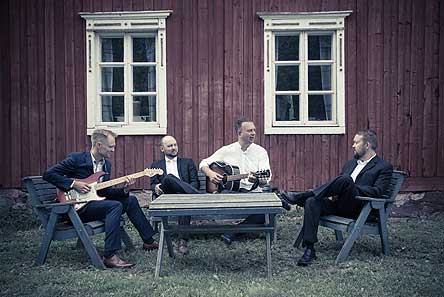 Mika
Jämsä: The first Eldanka was a combination of members
who lived in places nearby. I composed a couple of tunes and made
a demo with a drummer. When I got a gig we needed other members. The
bass player Mauri actually started from scratch and rhythm guitarist
Miika was almost underage. We operated a few years, very successfully,
but a couple of members moved after work elsewhere having very different
timetables. I had a full album of material ready for many years but
we didn’t even manage to make the
Mika
Jämsä: The first Eldanka was a combination of members
who lived in places nearby. I composed a couple of tunes and made
a demo with a drummer. When I got a gig we needed other members. The
bass player Mauri actually started from scratch and rhythm guitarist
Miika was almost underage. We operated a few years, very successfully,
but a couple of members moved after work elsewhere having very different
timetables. I had a full album of material ready for many years but
we didn’t even manage to make the
rehearsals. Although the band was perfect, the only way to go forward
was to replace members.
I found new guys for the band from my workplace, Kaustinen music college.
They were teaching instruments but didn’t have too many other
projects. They were eager to join the group and everything has been
easy and straightforward. The thing that unites us is that we collect
and invest in stylish vintage equipment from the ”Beatles period”.
mwe3: How about amps you prefer?
Mika Jämsä: In the days of our first release, I owned
a Fender Vibrolux Reverb amp and the first Eldanka album, Twangin'
Tritones is played with that instead of Vox AC30 I normally play
with. I just plugged in the guitar in and echo comes from the software.
That doesn’t satisfy me ’cause it should have been done
with traditional way with tape echoes.
On
the second album I used three amps and a JMX ET-520 tape echo or Strymon
El Capistan tape echo modeler, primarily without any compression or
sustainer for trying to capture the original 1960’s sound. We
played everything live together and there’s minimum amount of
corrections. I principally used Vox AC30 Top Boost and AC15 amplifiers
from the 1990s, but “Springfields” and “November”
are played through a tiny Fender Pro Junior amp. That’s some
lovely equipment. On Rusty Treasures there are also acoustic
guitars and other additional instruments to color a couple of tracks.
Maybe next time we’ll go in stick with a plain electric guitar
assembly.
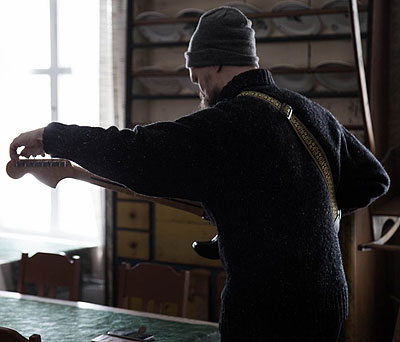 mwe3:
You were also speaking about the not-yet-released Eldanka album waiting
in the wings. Can you say a few things about a planned to be released
album?
mwe3:
You were also speaking about the not-yet-released Eldanka album waiting
in the wings. Can you say a few things about a planned to be released
album?
Mika Jämsä: We have the material almost ready for
the next album. We’re planning to record it in a shorter sessions
one track at a time. We also have a lot of new vintage gear to break
in the new record. A 1964 Vox AC30 and an awesome 1971 Fender Dual
Showman Reverb with the original 2x15 cab. We’re finding really
good real sounds combined with the new original compositions. When
everything matches and the stars are in the right position it could
be something.
mwe3: Why do you call the new Eldanka album Rusty Treasures?
You even have some rust on the cover art. What does the Rust symbolize?
Like Neil Young said, ”Rust never sleeps”.
Mika Jämsä: I found the cover artist, Leena
from my neighbor. She makes amazing digital art from photos. The name
of the album actually came from her work I chose for our album cover.
Rust symbolizes old guitar strings and equipment and the reputation
of 1960’s instrumental pop music. As a self-satisfied person,
I think the tunes are the treasures. Like Neil Young, classical instro
music is timeless.
mwe3: There’s so many great tracks on Rusty Treasures.
Do you have any personal favorites? How about the lead off track
“SUP Rider”? What does the title signify? That track was
written by Mauri Haapamäki. What else can you add in about that
track?
Mika Jämsä: I like them all and they’re very
different. “Dumb Step” is a cheerful and an irritating ear
worm. “Springfields” is maybe the most out of the ordinary
in my own style. “SUP Rider” was written by our bass player
Mauri. He’s done one piece for both albums. He is very talented
musically, despite his making a living as a silversmith.
Everyone knows the legendary track called “Surf Rider” and
“SUP Rider” is a Finnish reference. We don’t have big
waves to surf but Sup boarding in our still lakes is a growing entertainment.
mwe3: It will be hard to top it but “Paranta Beach”
is one of my favorite tracks on the new album. Where is that beach?
It’s one of the most Shadows influenced tracks and the melody
is memorable. What is the story on “Paranta Beach”?
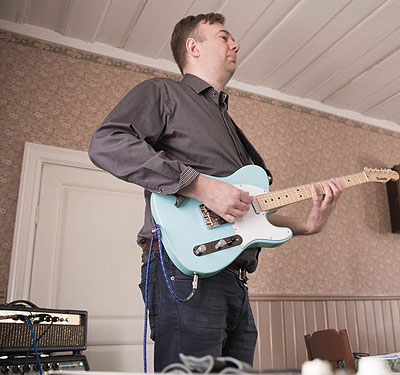 Mika
Jämsä: Finland is a country of a thousand lakes and
Paranta Beach is a nearby beach at the very idyllic little lake Lestijärvi.
In the tune there’s the same kind of cozy feeling and we even
did relaxing waves with the cymbal to solo part. The melody is a simple
pastiche of a Shadows-like 1960s tune featuring an acoustic rhythm
guitar. There are a bit of Mexican trumpet sounds and Spanish Paso
Doble loans. I know this one pleases the old time fans. The lead guitar
sound tries to recreate an early Shadows style with sounds from a
short tape echo with a large dynamic range. The solo part replicates
the old Finnish accordion tango style.
Mika
Jämsä: Finland is a country of a thousand lakes and
Paranta Beach is a nearby beach at the very idyllic little lake Lestijärvi.
In the tune there’s the same kind of cozy feeling and we even
did relaxing waves with the cymbal to solo part. The melody is a simple
pastiche of a Shadows-like 1960s tune featuring an acoustic rhythm
guitar. There are a bit of Mexican trumpet sounds and Spanish Paso
Doble loans. I know this one pleases the old time fans. The lead guitar
sound tries to recreate an early Shadows style with sounds from a
short tape echo with a large dynamic range. The solo part replicates
the old Finnish accordion tango style.
mwe3: “Slap Me” is a fun track. Does it have a kind
of James Bond effect in it?
Mika Jämsä: Yes, I’ve listened to a lot of John
Barry and James Bond music. I suppose the melody is like a Finnish
tango melody… a hidden tango.
mwe3: Does “The Promise” have a kind of Finnish or
even Swedish sound with a folkloristic kind of melody? How influenced
are you by Finnish folk music and even Swedish folk melodies and is
that one of the deep tracks on the new album?
Mika Jämsä: The folk music influences are obvious,
even the Irish accent. I’m become very familiar with traditional
Scandinavian and Irish violin tunes and eager to reiterate with twang
guitar. That differs so much from others, so much so, that I founded
a new assembly to play twangy folk music. Tres Nachos is my secondary
project – not recorded yet.
mwe3: “Treasure” has a definite Scandinavian guitar
sound to it. It’s also the shortest track on Rusty Treasures.
Is that track a real fun tune to play live? Your guitar technique
is amazing on that track. Over in a flash too…
Mika Jämsä: This track is influenced by game music.
There’s some kind of rock in my local forest and old people say
there’s a treasure inside. The A part riff is played by Rasmus
and a surf guitar, the part B lead is properly echoed. That’s
a funny power piece to play.
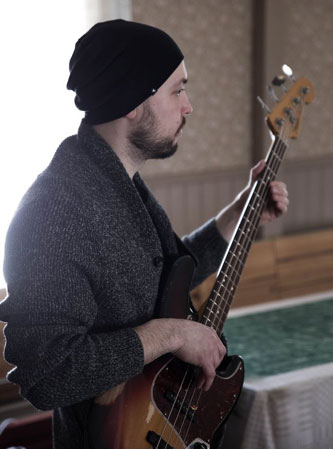 mwe3:
I recall Pipeline’s album review of Rusty Treasures mentioned
“Threnody For My Pet Pony”. Is it a kind of eulogy and what
can you add about the track title? Does the track have a kind of Western
music vibe? I like the contrasting moods in the track and the galloping
horses type sounds after the elegy melodic sound. Is there a touch
of Spaghetti Western sounds on “Threnody”?
mwe3:
I recall Pipeline’s album review of Rusty Treasures mentioned
“Threnody For My Pet Pony”. Is it a kind of eulogy and what
can you add about the track title? Does the track have a kind of Western
music vibe? I like the contrasting moods in the track and the galloping
horses type sounds after the elegy melodic sound. Is there a touch
of Spaghetti Western sounds on “Threnody”?
Mika Jämsä: You’re absolutely right mentioning
Spaghetti Westerns. I like the colors of Morricone’s minor chords
with inversions. My daughter had a pet pony who died from a Laminitis.
The A part has a sad funeral mood but in the B part recalls the cheerful
gallops and moments in a field when everything was fine. Musical humor
supposed to be?
mwe3: “Bend Or Stretch” has a cool title and it has
a kind of country and western type of twang to it. The track goes
into several moods. What kind of sound were you going for on “Bend
Or Stretch”?
Mika Jämsä: When I did my military service time schedule
started with bending and stretching at 6 AM every morning in the field
yard. Nobody ever came to lead the stretching and it took a couple
of mornings until we realized it’s only a joke. The A part is
like a vocal folk melody used by bending the strings and stretching
the tremolo arm. Someone has said composer should never explain his
works and now I’m doing that same mistake. We thought that the
B part will open the doors to the country music halls but thus far
it hasn’t. Someone recently told us that “good old Rautalanka
tune has the same beat from the beginning until the end. Your music
is not acceptable!” Having different moods within the same
piece is typical to us… though maybe not recommend by dancers.
mwe3:
“Dumb Step” brings a kind of humorous edge to it. Does the
track have a kind of Duane Eddy sound to it? Was Duane a big influence
on your playing? There’s also a kind of funky edge to it to.
It’s short but sweet.
Mika Jämsä: Funny that you mentioned Duane Eddy ’cause
“Dancing With The Guitar Man” is an example of the ”solo
part” riff. You also can find Chuck Berry lick there and Brian
Setzer and… I admit, my music and playing has a lot of loans,
or rather influences, but I’m glad when someone recognizes them.
mwe3: Does “SF Surf” bring in a kind of West Coast
touch to it? It also sounds a bit classical as well? The rolling drum
sound is great as well. Why do you call it “SF Surf”? Is
it one of Eldanka’s more torrential sounding tracks, done in
a kind of 1960s style, although it’s very original sounding too.
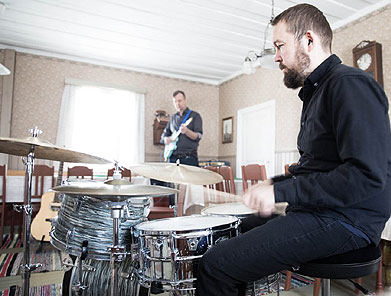 Mika
Jämsä: I think there should be even more rolling snares
in our album. It was hard work to beg the drummer for at least one.
If you mean West Coast as a surf style, I’m pleased. To us it
sounds more Eastern or even like Balkan folk music. The B part could
be from western movie. The original name of the track was “Surf
From the Bottom of the Rectum”. But a couple years ago, we performed
in a formal ceremony celebrating 100 years old independent Finland
and we understood to change the name. SF is our nationality sign –
Suomi Finland.
Mika
Jämsä: I think there should be even more rolling snares
in our album. It was hard work to beg the drummer for at least one.
If you mean West Coast as a surf style, I’m pleased. To us it
sounds more Eastern or even like Balkan folk music. The B part could
be from western movie. The original name of the track was “Surf
From the Bottom of the Rectum”. But a couple years ago, we performed
in a formal ceremony celebrating 100 years old independent Finland
and we understood to change the name. SF is our nationality sign –
Suomi Finland.
mwe3: “November” is a deep track. There’s a
kind of mournful edge to it and I think some of the melodies are almost
progressive rock in nature. Is the melody inspired by Finnish folk
music and is Rasmus Tammik playing the lead guitar on that track?
How do you and Rasmus share the guitar chores in Eldanka?
Mika Jämsä: This track reflects the stagnant mood
of long and dark autumn in Finland. Also the depopulating countryside
and emptiness is present. Finnish blues. Rasmus plays his only improvised
solo thus far. Otherwise we have exact roles. I play the lead with
a tape echo and he plays rhythm and reverb-surf guitars. That’s
the way we combine British and American styles together. Rasmus is
a skillful jazz guitarist and he’s also interested in American
traditional folk and country guitar styles also in this genre. He
assembled his Telecaster guitars and Fender Tube Amps by himself.
mwe3: “Jopo -The First Ride” changes the mood to
a more lighthearted guitar sound. The early Shadows / Ventures and
also the early 1960s influence is also apparent. What was your idea
on that track and is there also your trumpet and several other unusual
instruments on that track?
Mika
Jämsä: Jopo is a Finnish well-known retro bike, pleasant
to ride in no hurry. I’ll be satisfied you recognized the influences
again. I’ve never heard surf guitar with a piccolo flute and
I thought it would be funny and matching combination. The trumpet
is supposed to relate to a Tex-Mex sound again but the rhythmic pattern
is from Sibelius’ Finlandia.
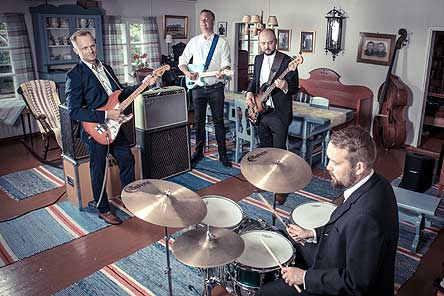 mwe3:
“Springfields” has gotten a lot great feedback and it’s
a stunning close to a brilliant album. What brought on “Springfields”
and why did you close Rusty Treasures with that track? Is there
something unusual about the title of the song or is it another way
to say evergreen?
mwe3:
“Springfields” has gotten a lot great feedback and it’s
a stunning close to a brilliant album. What brought on “Springfields”
and why did you close Rusty Treasures with that track? Is there
something unusual about the title of the song or is it another way
to say evergreen?
Mika Jämsä: Nice to hear! The album is a mixture
of very different styles of pieces that maybe will be challenging
to the listener. We wanted to close the album in a calmness and harmony.
“Springfields” was composed during the Christmas holidays
waiting for the sparkling snow fields in the increasing sunlight of
an approaching spring. It’s a simple and straight tune to give
a close up with a hopeful ending. People, mostly like this little
tune.
mwe3: What’s been the reaction to Rusty Treasures in
Finland and in other countries? I feel certain to say it will be on
many best-of lists among the in-the-know guitar enthusiasts all over
the world. What other plans to you and the band have for 2019 as we
enter the last half of the year? We’re almost at 2020.
Mika Jämsä: The hardest part is to reach people who
might be interested in our music. When they do hear us everyone finds
something to be fond of. The Rautalanka enthusiasts in Finland are
quite conservative but the reviews have been grateful. Compared to
pure instro rock, vocal pop and dance music, over-represented in genre’s
happenings, Surf rock is considered an upstart!
We’ve done two satisfying albums and it seems like someone else
has gotten wind of our music at last. There’s been more sold
elsewhere in the world more than among our own relatives. We’re
not party band playing fatally worn-out cover songs and you have to
have a perverted humor when trying to dance to our music. But we are
a housebroken and meek live band and if you offer a beer after a gig
we’ll have never-ending discussions about guitars and other equipment.
Someone occasionally gets the point behind our music and then they
become very loyal fans.
 This
summer we have couple of gigs and then we’re gonna concentrate
on our next album. We hope that releasing material that satisfies
ourselves will bear fruit some day. If we sell enough, we’ll
aim to release an analog vinyl record or vinyl singles. It could be
also a collection of three full albums thus far played again with
older and shabbier sounds with less microphones and digitally. We’re
going deeper to originality and creating new material. If there’s
a millionaire who loves a good guitar instro somewhere... let’s
make a deal!
This
summer we have couple of gigs and then we’re gonna concentrate
on our next album. We hope that releasing material that satisfies
ourselves will bear fruit some day. If we sell enough, we’ll
aim to release an analog vinyl record or vinyl singles. It could be
also a collection of three full albums thus far played again with
older and shabbier sounds with less microphones and digitally. We’re
going deeper to originality and creating new material. If there’s
a millionaire who loves a good guitar instro somewhere... let’s
make a deal!



